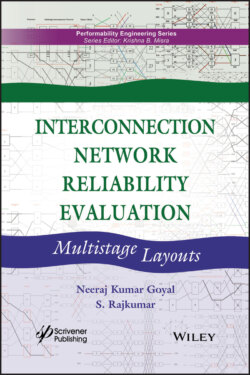Читать книгу Interconnection Network Reliability Evaluation - Neeraj Kumar Goyal - Страница 11
Оглавление
Preface
Network reliability evaluation for complex communication networks is a time-consuming task. Complex networks such as computer communication networks, telecommunication networks, transport networks, etc. are an integral part of our daily life. Complex networks interconnect multiple processing units in distributed systems. Performance of such networks can be measured by evaluating the reliability index, which represents the probability that the network operates satisfactorily for a given period of time when used under stated operating conditions. A network designer has to choose suitable fault-tolerant and highly reliable network architecture to avoid performance degradation and carry out multiple communication tasks concurrently.
Parallel computers with multiple processors have emerged to meet energy-efficient performance demands of current and future challenging computing applications. These multiprocessor systems need interconnection networks for connecting processors and memory modules. Advances in parallel and distributed computing have made interconnection networks a potential networking alternative to meet the growing demands of high-performance computing applications. These networks need to perform continuously without repair for long periods of time. Therefore, these need to be reliable and fault-tolerant as these networks are quite complex and big in size. Failure of its components should not lead to complete network failure as it may be catastrophic.
The main objective of this book is to device approaches for reliability modeling and evaluation of such complex networks. Such evaluation helps to understand which network can give us better reliability by their design. New designs of fault-tolerant interconnection network layouts are proposed, which are capable of providing high reliability through path redundancy and fault tolerance through reduction of common elements in paths. This book covers the reliability evaluation of various network topologies considering multiple reliability performance parameters (two terminal reliability, broadcast reliability, all terminal reliability, and multiple sources to multiple destinations reliability).
For decades, work on network reliability evaluation has been going on. Our S.C. School of Quality and Reliability, earlier known as Reliability Engineering Centre, has significantly contributed to this area of research during the 1980s and onwards. The school has been involved in developing models for reliability evaluation of complex networks but static and ad hoc. The authors of this paper have significant contributions in this area.
Interconnection networks pose another challenge to reliability evaluation due to their complex and large architectures. There are very few in this area. This subject matter has not been much addressed in easy-to-follow book materials. This book tries to bring the aspects of latest research conducted at S.C. School of Quality and Reliability to have better reach to audiences. This is the first edition of the book, so there are many improvements possible. The authors can be provided with feedback to improve the contents of the book in the possible next edition.
This book first introduces the basic concepts of network reliability and the popular interconnection network architectures in the first two chapters. Then it discusses approaches used for reliability evaluation of such a network in Chapters 3, 4, and 5. Some new novel architectures providing better reliability and fault tolerance while being cost effective are presented in Chapter 6.
The authors would like to thank everyone (faculty, students, and staff) from S.C. School of Quality and Reliability, IIT Kharagpur, India, for their encouragement, suggestions, and support while carrying this analysis. We would also like to thank Prof. K.B. Mishra and Martin Scrivener for their guidance and support in writing this book.
Dr. Neeraj Kumar Goyal and Dr. S. Rajkumar
August 2020
